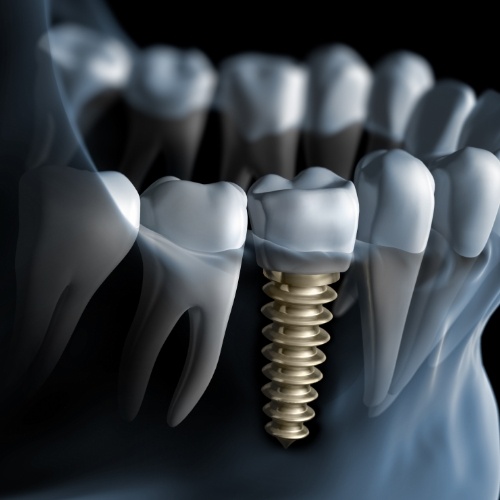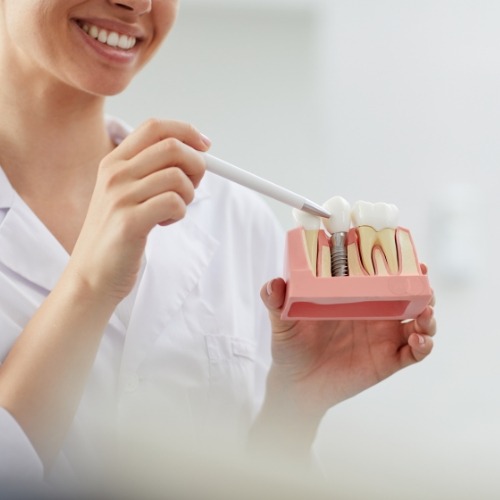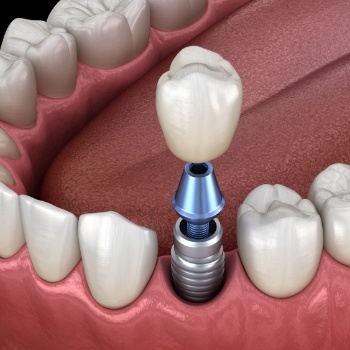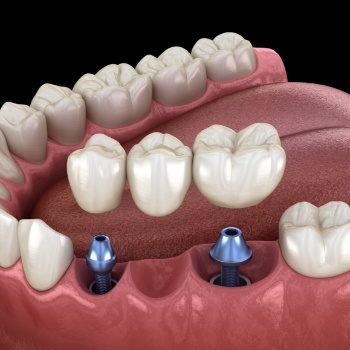Dental Implants – Olympia, WA
The Complete Answer for Missing Teeth

When it comes to replacing your teeth, there are plenty of options for filling in the gaps that are visible to everyone that looks at your smile. But what about the missing tooth roots? With traditional dentures and bridges, the problem goes completely unaddressed, and the underlying bone starts to break down as a result. Dental implants are the only option that completely replaces your tooth roots as well as the crowns. To learn more about the benefits of this treatment and see whether it’s right for you, make an appointment with Dr. Chong today.
What are Dental Implants?

A dental implant is made up of a biocompatible post, a customized restoration, and a metal abutment. We surgically place the post into the jawbone and wait for it to form a bond with the surrounding tissue. Then we can attach the metal abutment that will be used to anchor the final restoration in place; said restoration will be made to be virtually indistinguishable from the rest of your teeth.
The 4-Step Dental Implant Process

At Capital City Smiles, the entire dental implant process takes place under a single roof, and our dental team will be with you during every step. Step one is a consultation so that we can confirm that you can get implants, and we’ll put together a plan for making the treatment a success. After undergoing the surgery to place the implant posts in your jaw, osseointegration (the process of the implant and jawbone joining) takes place over three to six months. Once the abutment has been connected to the post, we only need to wait for your mouth to heal completely before we can start designing the final restoration, which is placed at the last visit following any last-minute adjustments.
Benefits of Dental Implants

- Improved Chewing: Dental implants let you regain up to 70% of the biting force of your original teeth. This is enough to let you comfortably eat almost anything you could before, letting you enjoy a healthy diet without limitations.
- Prevent Bone Loss: While traditional tooth replacements offer no answer for stopping bone loss in the jaw, dental implants provide the stimulation needed to actually prevent it.
- No Slipping: Tired of having your dentures move around while you’re trying to eat? Dental implants will keep your new teeth in place at all times.
- Extremely Successful: Dental implants have a success rate of 95% and can last anywhere between 25 years and a lifetime.
Who Dental Implants Can Help

Dental bridges are used to replace one tooth or a few consecutive teeth. Dentures are known to help replace entire rows of teeth. Dental implants, on the other hand, can be used to replace any number of teeth at all as long as your mouth is healthy, and your jawbone is capable of supporting the implant posts. We can suggest the following options for replacing your missing teeth if you are found to be a good candidate for dental implant surgery:
Missing Single Tooth

When missing just one tooth, the math is very simple: we only need to place one titanium implant in your jaw. Eventually, a crown will be attached to the implant post to complete the treatment. Implant crowns are a more enamel-friendly alternative to dental bridges since the nearby teeth don’t need to be modified to place them.
Missing Multiple Teeth

When replacing multiple teeth, we don’t need to use a separate implant for every single tooth. In fact, we can use just two implants to bring back three or more teeth in a row by using a dental bridge.
Understanding the Cost of Dental Implants

As you can probably expect, dental implants are usually more expensive than dental bridges. The exact amount they cost isn’t set in stone; it usually depends on a combination of factors like how many teeth are missing and whether additional treatments like bone grafts are needed. Dental implants are meant to last for decades, so bear in mind that the initial cost can be offset by the fact that you probably won’t need new implants in the future (unlike other prosthetics that need to be replaced every 5-10 years).



